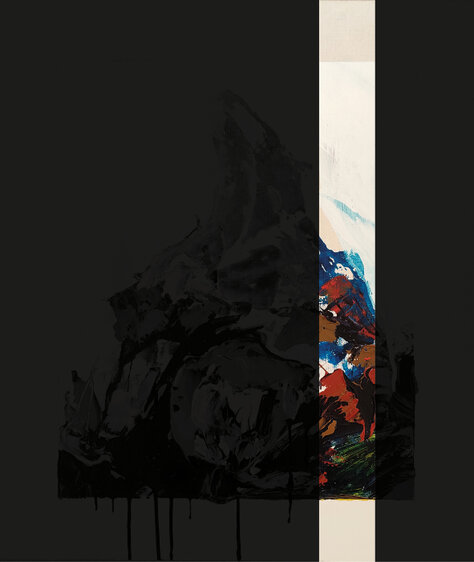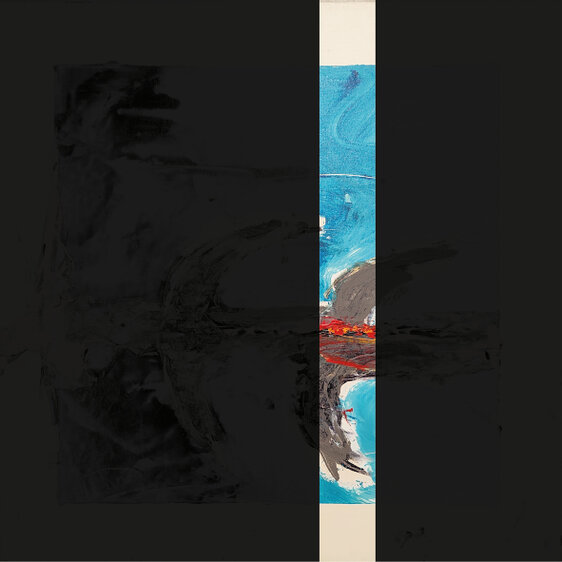MARIO SCHIFANO
Mario Schifano was born in Libya (Homs) in 1934, where he spent only the early years of his childhood. After moving to Rome with his family post-war, he showed little interest in formal education and began working at the Etruscan Museum of Valle Giulia, restoring vases and drawing tomb layouts—a craft he learned from his father, an archaeological restorer. However, as his passion for painting grew, he left this profession behind and had his first exhibition at the Galleria Appia Antica in Rome in 1959. Presented by Emilio Villa, his early works were aligned with the Informal Art movement, marked by gestural expression and thick material textures. In 1960, Schifano took part in an exhibition at La Salita Gallery, curated by Pierre Restany: Cinque pittori romani (Five Roman Painters), with Angeli, Festa, Lo Savio, Schifano, and Uncini. This exhibition marked the start of a prolific artistic period that lasted over a decade, during which he gained critical recognition, winning awards like the Premio Lissone (Lissone, 1961) and Premio Fiorino, La Nuova Figurazione (Florence, 1963). His painting evolved towards monochrome works on paper affixed to canvas, treated as screens onto which letters, symbols, and advertising images began to appear, particularly from the end of 1962. Throughout this period, Schifano was involved in numerous solo and group exhibitions in Italy (Rome: La Tartaruga, 1961; Galleria Nazionale d'Arte Moderna, 1966; L’Attico, 1967; Milan: L’Ariete, 1963; Studio Marconi, 1965; Venice: XXXII Biennale, 1964; San Marino: V Biennale, Oltre l’Informale, 1963; VI Biennale, 1965) and abroad (New York: Sidney Janis Gallery, The New Realists, 1962; Paris: Sonnabend, 1963; Pittsburgh: Carnegie Institute, 1964; São Paulo: Biennale, 1965; Tokyo: National Museum of Modern Art, 1967). During the 1960s, Schifano also traveled extensively to America (1962 and late 1963–early 1964), where he encountered Pop Art and works by artists like Franz Kline and Jim Dine, which had a profound impact on him. In 1963, he began creating the Paesaggi Anemici (Anemic Landscapes), in which he depicted natural elements not from direct experience, but as pre-existing images, fragmented and reinterpreted through allusion. This period also saw Schifano frequenting Caffè Rosati, where the "Scuola di Piazza del Popolo" met and engaged in continuous artistic discussions. From 1964 to 1965, Schifano dedicated a famous series of works to Futurism, drawing from a 1912 photograph of the Futurist group in Paris (Boccioni, Severini, Carrà, Russolo, Marinetti), reimagining these figures as silhouettes evoked from memory, set beneath colored Perspex panels. Schifano’s interest in technology, image reproduction, urban life, music, advertising, and photography began to merge with his exploration of film. His cinematic experiments began in the early 1960s, leading to several short films, a feature film (Anna Carini vista in agosto dalle farfalle, Studio Marconi, 1967), and a trilogy: Satellite, Umano non umano, Trapianto, consunzione e morte di Franco Brocani.
In the early 1970s, Schifano created the Televisori series, where he applied emulsified paint to canvases featuring images extracted from television screens and altered with nitro paint. These works were inspired by his "auxiliary muse" (television), and his hand-retouched photographs later featured in a traveling exhibition in Brazil (Fundação Memorial da América Latina, 1996), Buenos Aires (Museo Nacional de Bellas Artes, 1997), Havana (Fundación Wilfredo Lam, 1998), and Mexico City (Museo de Arte Carrillo Gil, 1998). Schifano’s exhibition schedule continued to thrive with both solo and group shows, particularly in Italy (Rome: Studio Soligo, 1970; Palazzo delle Esposizioni, X Quadriennale; Villa Borghese Parking Lot, Contemporanea, 1973, curated by Achille Bonito Oliva; Parma: La Steccata, 1973; University of Parma, 1974; Naples: Lia Rumma, 1973; Bologna: Galleria Nazionale d’Arte Moderna, 1976; Venice: XXXVIII Biennale, 1978; Ferrara: Palazzo dei Diamanti, 1979). However, from the late 1960s onward, his work was affected by existential crises, drug issues, and multiple institutionalizations. After these turbulent years, Schifano returned to painting that revisited historical avant-garde figures such as Magritte, de Chirico, Boccioni, Picabia, and Cézanne, while also reinterpreting his own earlier works. By the 1970s and 1980s, his work embraced a more traditional approach, rich in gestural expression and materiality. The critical recognition he received from figures like Maurizio Calvesi and Germano Celant ensured his ongoing presence in important exhibitions in Italy (Rome: Palazzo delle Esposizioni, Arte e Critica, 1980; Venice: XL Biennale, 1982; XLI Biennale, 1984; Ferrara: Padiglione d’Arte Contemporanea, 1989; Milan: Palazzo della Triennale, 1995; Verona: Palazzo Forti, 1997) and internationally, especially in the 1990s (Paris: Centre Pompidou, Identité Italienne, 1981; San Francisco: Museo Italo-Americano, 1985; Porto: Museu de Arte Contemporânea, 1986; Frankfurt: Kunstverein, 1987; London: Royal Academy, 1989; Brussels: Palais des Beaux-Arts, 1989; New York: Solomon R. Guggenheim Museum, 1994; Beijing: International Exhibition Center, 1997). His later work focused on prehistoric themes and natural phenomena—often reproduced and filtered through memory—highlighted in exhibitions such as Naturale sconosciuto (Venice, Palazzo delle Prigioni Vecchie, 1984), Aosta (Tour Fromage, 1988), Paris (Galerie Maeght, 1988), and Saint-Priest (Centre d’Art Contemporain, 1992). He was also involved in social activism, funding research groups and initiatives with the proceeds from his art sales. In 1997, Schifano was awarded the Premio San Giorgio di Donatello for his polychrome stained-glass windows at the crypt of Santa Croce in Florence, marking the church's seventh centenary. Mario Schifano passed away in Rome in 1998, and two years later, the Venice Biennale held a major retrospective in his honor.
Images protected by copyright
To receive and view images, please contact the gallery or write to: info@jusmuseum.com
→ 01 SENZA TITOLO (NATURA VIVA), ,1990s, cardboard collage on black cardboard, phosphor colours, cm 100x70
→ 02 SENZA TITOLO, 1990, mixed media and sand on canvas with overgrown frame, cm 59x59
→ 03 SENZA TITOLO,1990s, enamel and acrylic on canvas, cm 70x60
→ 04 SENZA TITOLO, anni '90, enamel and acrylic on canvas, cm 70x70





